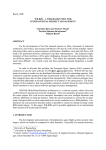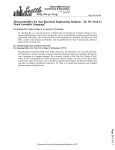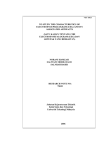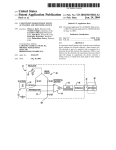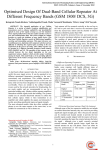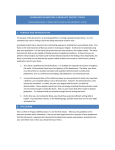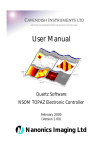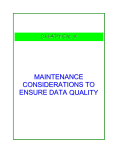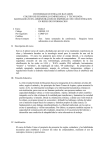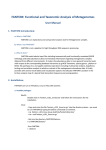Download Low Cost Test Platform for a Basic Electrical Measurements
Transcript
Session 11a4 Low Cost Test Platform for a Basic Electrical Measurements Laboratory Ricardo Mediavilla Engineering Department Inter American University of Puerto Rico, Bayamón Campus Bayamón, PR 00957 Abstract - In introductory circuit analysis and electronics laboratories students face multiple challenges. They must be able to measure, discover, analyze, or explain electrical phenomena or principles using test sets that in general are not user friendly, do not talk to each other, and are limited in their data collection, processing, printing, and plotting capabilities. Sometimes the effort required to collect the data may even shadow the main objective of the laboratory, experiment, or design project being conducted. Hispanic minorities typically also face the additional problem of having to deal with instrument manuals and instructions written in English, a second language for them. Moreover, to educational institutions, basic electrical measurements test sets represent a major acquisition investment. As a proposed solution, a low cost, user friendly test platform has been developed. It consists of a personal computer with a multifunction PCI data acquisition card controlled by a graphical programming language. Introduction Modern test sets are seldom easy to use. Typically they have many options and features that although powerful and useful to the experienced user, can be quite confusing to the novice electrical engineering or electronics student. Hispanic minorities typically also face the additional problem of having to deal with instrument manuals and instructions written in English, a second language for them. Sometimes the effort required collecting electrical measurements data might even shadow the main objective of the laboratory, experiment, or design project being conducted. Laboratories play an essential role in an electrical engineering or in an electronics curriculum. Computer simulations help, but are not a substitute for hands on testing in a laboratory [1]. Without the laboratories, students would not acquire the basic skills demanded by their profession. However, in addition to the complexity of the test sets, educational institutions also face a staggering cost issue. Test sets are expensive to acquire. Since typically each test set has its own power supply, its own set of knobs and control switches, its own digital or analog readout displays or screens, and its own casing or chassis, educational institutions end up paying for redundant components. To eliminate redundant components in a laboratory test station, and to facilitate instrument operation by non-skilled users, multiple authors, [2], [3], and [4], have in the past proposed the use of virtual instruments. Virtual instruments become even more relevant as language options are offered to the user and as a PCI data acquisition and control card (DAC) readily integrates into a user friendly graphical programming language thus facilitating instrument development. Right from the beginning, user friendliness was a key design requirement the developed station had to comply with. User interface screens played a key role achieving compliance with this requirement. A welcome screen prompts the user for the language of choice, English or Spanish. From that point on, all the commands, instructions, hints, and options will appear, not in dual language, which would be quite confusing, but in the language chosen by the user. In addition to the language options, colors have been used to guide the user. All the knobs and controls related to a common function share the same color. The main objective was to have simple instruments with all the basic capabilities operating in the language of choice of the student and in a user friendly and non-threatening environment. Although in principle almost any high level language could have been used to develop the test platform, conventional high level languages would have required a major investment in time and effort. In addition, control of the DAC card and the development of user interface screens would have been much harder to achieve than with a graphical programming language. A graphical programming language facilitates the implementation of virtual instruments and user interface panels. Virtual test sets covering the basic functions found in power supplies, oscilloscopes, multi meters, frequency counters, function generators and spectrum analyzers have been implemented using a graphical programming language. User selectable hint and help icons provide assistance, if needed. System Components The main components of the system are an IBM compatible personal computer (PC), one DAC card with its corresponding shielded cable, patch panel, interconnection box, and associated cables, connectors, and test leads, plus the HP VEE graphical programming language. Data Translation’s visual programming interface (VPI) DT3010 was chosen. The DT VPI DAC card integrates into the HP VEE as a regular icon thus allowing easy access to the collected data and facilitating instrument control. In the DT3010, special built-in icons allow control of 32 single 0-7803-5643-8/99/$10.00 © 1999 IEEE November 10 - 13, 1999 San Juan, Puerto Rico 29th ASEE/IEEE Frontiers in Education Conference 11a4-18 Session 11a4 mode analog inputs (or 16 analog inputs in differential mode), 2 analog outputs, 4 user counter/timers, and 16 input/output lines. A patch panel, also manufactured by the DAC card supplier, allows easy access to each one of the input and output channels, plus timers and clocks. Twisted pair wires connect the patch panel ports with either banana plug or BNC connectors in a metal box. The oscilloscope has two dedicated BNC connectors, one per channel. A third BNC connector serves as the input port to the spectrum analyzer. All the other instruments have dedicated banana plug type output ports. Users just have to plug in the test leads into either banana plug or BNC type of connectors. All current sources are protected with fuses, either 100 mA, or 5 mA micro fuses. Test equipment is expensive. A single fully equipped station for a basic electrical measurements laboratory with frequency domain analysis capabilities can easily exceed $10 K. In addition to the capital investment, additional expenses include maintenance, equipment calibration, workbenches, and floor space. Even if several test sets are stacked on top of each other, a table or workbench large enough to accommodate all the equipment and allow reasonable user working space is required. The total cost of the developed system, including a high performance PC and all the additional components, is less than $ 6 K per station. However, if several stations are assembled and only one, the development station, runs the full software while the remaining ones are loaded with run time versions, then software costs can be spread over a larger base thus reducing even more the per unit cost. Educational institutions may find the proposed configuration easier to economically justify since the PC’s can also be used by a larger pool of students, and may serve multiple purposes, including word processing and spread sheet analysis, even for non electrical engineering or electronics majors. Software Architecture The following instruments have been developed: oscilloscope, digital multi meter with voltmeter, current meter, and ohmmeter options, frequency counter, power supply, function generator, and spectrum analyzer. To simplify programming, each instrument is contained within a User Object in the HP VEE graphical programming language. Future developments and options can be easily added to any particular instrument without affecting the overall architecture or any of the previously developed instruments. New instruments can easily be incorporated into the existing architecture. Oscilloscope As in [5], the virtual oscilloscope was designed with the intention of allowing students to make basic electrical measurements without having to deal with the intricacies of multiple knobs. Colors have been used to make the use of the oscilloscope virtual instrument even more intuitive. For example, it has two input channels and can display two waveforms. The channel 1 waveform is plotted in red while the channel 2 waveform is plotted in blue. All the knobs and settings controlling channel 1 are in red while all the knobs and settings controlling channel 2 are in blue. All the timing and trigger options are in yellow. Figure 1 shows the oscilloscope user interface screen. The built-in mathematical functions of the graphical programming language simplified the development of the application. For example, key controls in an oscilloscope are the DC/AC coupling for every channel. In a real oscilloscope, AC coupled signals pass through a capacitor to block the DC component. In a software implementation, the mean or DC value of the signal is mathematically calculated and then subtracted from the original array of data points. The same effect achieved by the blocking capacitor is achieved using software instructions, but with the advantage that the original signal is not distorted. In a real implementation students will observe the rise and fall time of the waveform due to the charging and discharging capacitor. The software implementation achieves a true DC removal without distorting the original waveform. Scales and conversion factors typically confuse students learning basic test and measurement techniques. To simplify their task, for each channel all the main signal statistics, maximum, minimum, root mean square, mean or DC value, and peak to peak are displayed. Markers facilitate relative time and relative amplitude measurements. Students can concentrate on the basic observations and waveforms. The computer will do the calculations for them. Like in a storage scope, waveforms can be stored in a data file for later retrieval, analysis by any other software application, or for plotting. All input analog channels, including the two oscilloscope channels, have been programmed to measure bipolar signals with a range of +/- 10 V, and a resolution of 12 bits. Multi Meter The multi meter may operate in any of the following three options: voltmeter, current meter, and ohmmeter. Each one of these three functions has a pair of input leads or wires and a separate channel assigned to it. Figure 2 shows the multi meter user interface screen. Figure 3 shows the voltmeter user interface screen. The user just selects the desired statistics (root mean square, average or DC, maximum, minimum, and peak to peak) and the measurement scale. The user interface screen clearly 0-7803-5643-8/99/$10.00 © 1999 IEEE November 10 - 13, 1999 San Juan, Puerto Rico 29th ASEE/IEEE Frontiers in Education Conference 11a4-19 Session 11a4 indicates the chosen option and includes both an analog and a digital display. To increase realism, the analog display has been programmed to change slowly, just like in a real analog voltmeter exhibiting a mechanical time constant in its analog display. The current meter is just a slight variation of the voltmeter implementation. A small resistor is used as a current sensing device. When the current to be measured passes through a small resistor, a voltage drop is recorded. Based on the recorded voltage drop and the known numerical value of the resistor, the software then uses Ohm’s law to calculate the actual current. Similarly, a known voltage source with a known series resistor and the unknown resistor in shunt is the basic arrangement for implementing the ohmmeter. Power Supply Figure 4 shows the power supply user interface screen. The user only has to turn on the instrument, use a software knob to select the desired output voltage, and watch the analog and digital output voltage displays. Like in the voltmeter, to increase realism, a time constant has been programmed to simulate the response time of a real analog display. In addition, students will observe that instruments, like all electrical systems, undergo transients and take time to react to changes in their input parameters. Since the DAC card must supply the output power and since it must derive it from the PC internal power supply, the maximum voltage range is limited to +/- 10 V. The maximum current is limited to +/- 5 mA. Users requiring a higher current output must instead rely on a fixed +5 V output port rated at a maximum current of 100 mA. Frequency Counter Figure 6 shows the frequency counter user interface screen. The frequency counter is implemented by counting the number of events or pulses in a specified time interval. The user has the options of either selecting fast single frequency measurements, or slower but more accurate average frequency measurements. Spectrum Analyzer Figure 7 shows the spectrum analyzer user interface screen. For simplicity only three controls knobs have been included: 1. Center frequency. 2. Resolution bandwidth which defines the maximum frequency span with respect to the center frequency. 3. Video bandwidth which filters noise components. The user also has the option of windowing the time series data using Bartlet, Hamming, Blackman, or Hanning windows. Like in the oscilloscope, the frequency range of operation is limited by the sampling rate of the DAC card. To avoid aliasing, the sampling frequency must exceed twice the highest frequency component of the sampled signal. Since the DAC card being used has a maximum sampling rate of 1.25 MHz, a wide frequency response is available for introductory electronics or circuit analysis courses. More advanced courses may require test sets to operate at even higher frequency ranges. Conclusion A low cost and user friendly test platform for a basic electrical measurements laboratory capable of servicing introductory level electronics and circuit analysis courses in Function Generator electrical engineering and electronics programs has been developed. Language options, color coding of knobs and The user selects the desired function: sine, cosine, controls, plus help and hint icons all contribute to create a square, triangular, positive ramp, negative ramp, or DC user friendly environment. waveform. Once the function has been selected, using Even though when compared with professional level software knobs, the DC offset or bias voltage, the phase instruments the test platform may be outperformed in terms offset, the amplitude, and the frequency are specified. Figure of accuracy, noise levels, speed, frequency range, voltage 5 shows the function generator user interface screen. To range, and power output, it is a reasonable economic generate the waveform, a virtual function generator in the alternative and a useful educational tool for basic electrical graphical programming language first numerically calculates measurements laboratories. Moreover, frequency domain the corresponding data points for the user selected analysis capabilities, typically found only in expensive test waveform. Then, a digital to analog conversion unit sets, are incorporated at no extra cost. Information synthesizes the analog voltage waveform based on the technology and electrical measurement technology have numerical data points and 12 bits of resolution. To generate been merged into the educational process. a periodic analog waveform, the same operation is Future developments include the following additional continuously repeated. A simple RC filter [6] is connected to options: 1. Adding to the function generator virtual the output leads to remove high frequency noise. Like in the instrument the capability of generating modulated signals power supply, the maximum output load is +/- 5 mA. So that and user defined arbitrary functions. 2. Adding to the the user will have a clear picture of the waveform that is oscilloscope the capability of automatically calculating the being generated, a numerical plot of the data from which the frequency and period of the recorded waveform. 3. Adding software synthesizes the actual waveform is portrayed in the to the frequency counter the capability of measuring relative user interface screen. phase differences or delay between two signals, and the 0-7803-5643-8/99/$10.00 © 1999 IEEE November 10 - 13, 1999 San Juan, Puerto Rico 29th ASEE/IEEE Frontiers in Education Conference 11a4-20 Session 11a4 capability of measuring pulse width. 4. Creating a new additional virtual instrument capable of automatically recording the frequency response, magnitude and phase as a function of frequency, for a device, circuit, or system. The project has a home page in the Internet. Additional details about the project can be obtained activating the research projects link at the Campus Internet page http://bc.inter.edu. [3] [4] Acknowledgment This work was supported by the National Science Foundation under grant DUE-9850603. References [5] [6] [1] Baker, R., Yunus, J., Taha, F., Hassan, I., Basir, S., Husain, F., Muda, Z., “Integration of Experimentation and Computerization”, Proceedings of the IEEE Multimedia Engineering Education Conference, July 1994, pp. 213-218. [2] Bucci, G., Landi, C., “Implementation of a Virtual Network Analyzer by Means of VXI-Based Modules”, [7] [8] [9] IEEE Instrumentation and Measurement Technology Conference, Ottawa, Canada, May 1997, pp. 246-250. Bucci, G., Landi, C., “VXI-Based Virtual Instrument in Undergraduate Measurement Laboratory Experiments”, IEEE Instrumentation and Measurement Technology Conference, Ottawa, Canada, May 1997, pp. 241-245. Maguire, D., Meckl, P., King, G., “Personal ComputerBased Task-Specific Instruments for Use in Analog Controls Education”, Proceedings of the American Control Conference, Seattle, Washington, June 1995, pp. 54-58. Adams, R., “The Virtual Oscilloscope: An Impedance Match to Beginning ECE Students”, IEEE Transactions on Education, Vol. 34, No. 4, November 1991, pp. 350356. DT 3010 Series – Getting Started Manual, First Edition, Data Translation, September 1998. DT VPI User Manual, Version 5.0, Second Edition, Data Translation, June 1998. Coombs, C., Electronic Instrument Handbook, Second Edition, McGraw Hill, 1995. Helsel, R., Visual Programming with HP VEE, Third Edition, Prentice Hall, 1998. Figure 1. Oscilloscope User Interface Screen 0-7803-5643-8/99/$10.00 © 1999 IEEE November 10 - 13, 1999 San Juan, Puerto Rico 29th ASEE/IEEE Frontiers in Education Conference 11a4-21 Session 11a4 Figure 2: Multi Meter User Interface Screen Figure 3: Voltmeter User Interface Screen Figure 4: Power Supply User Interface Screen 0-7803-5643-8/99/$10.00 © 1999 IEEE November 10 - 13, 1999 San Juan, Puerto Rico 29th ASEE/IEEE Frontiers in Education Conference 11a4-22 Session 11a4 Figure 5: Function Generator User Interface Screen Figure 6: Frequency Counter User Interface Screen Figure 7: Spectrum Analyzer User Interface Screen 0-7803-5643-8/99/$10.00 © 1999 IEEE November 10 - 13, 1999 San Juan, Puerto Rico 29th ASEE/IEEE Frontiers in Education Conference 11a4-23






